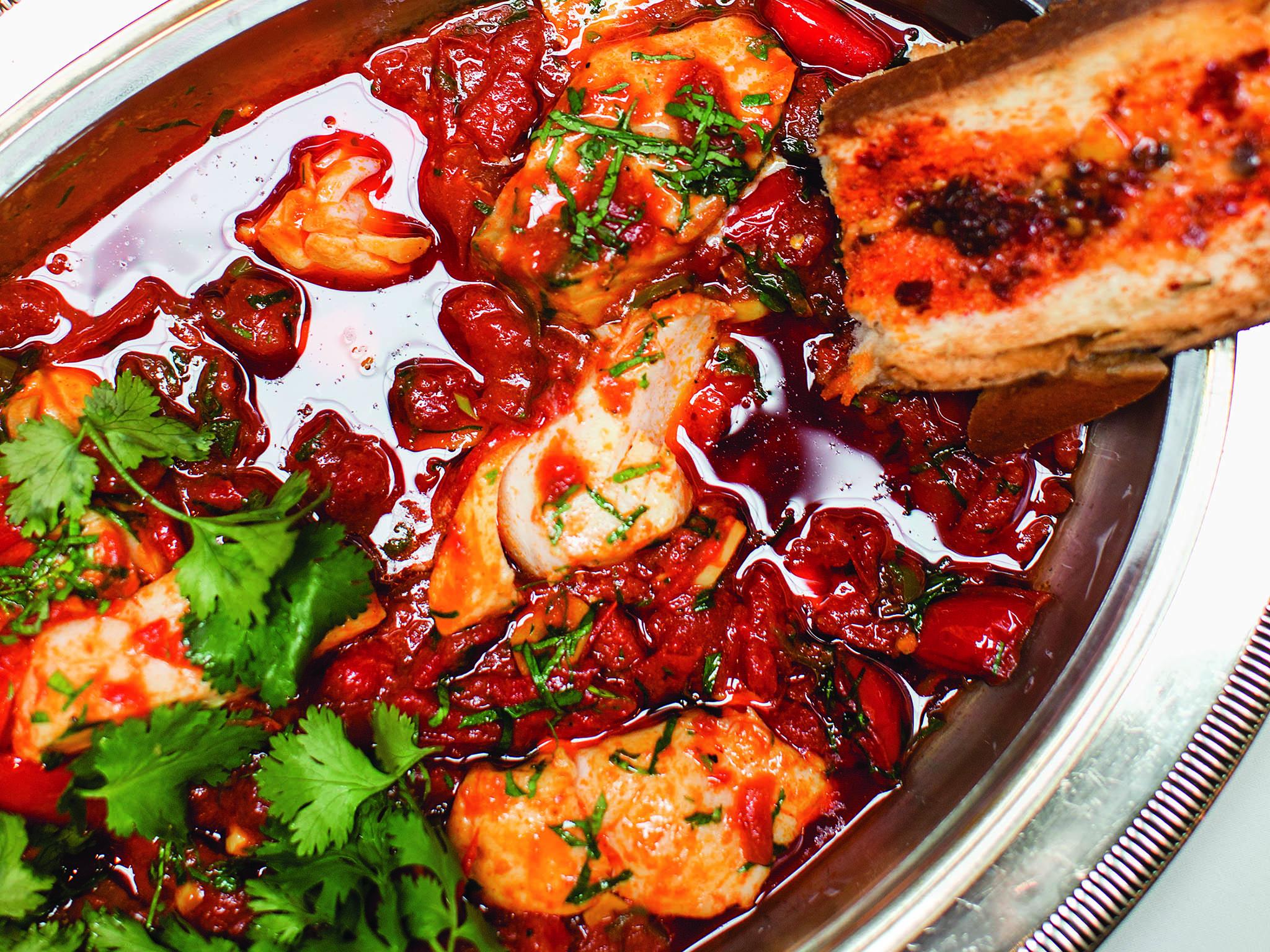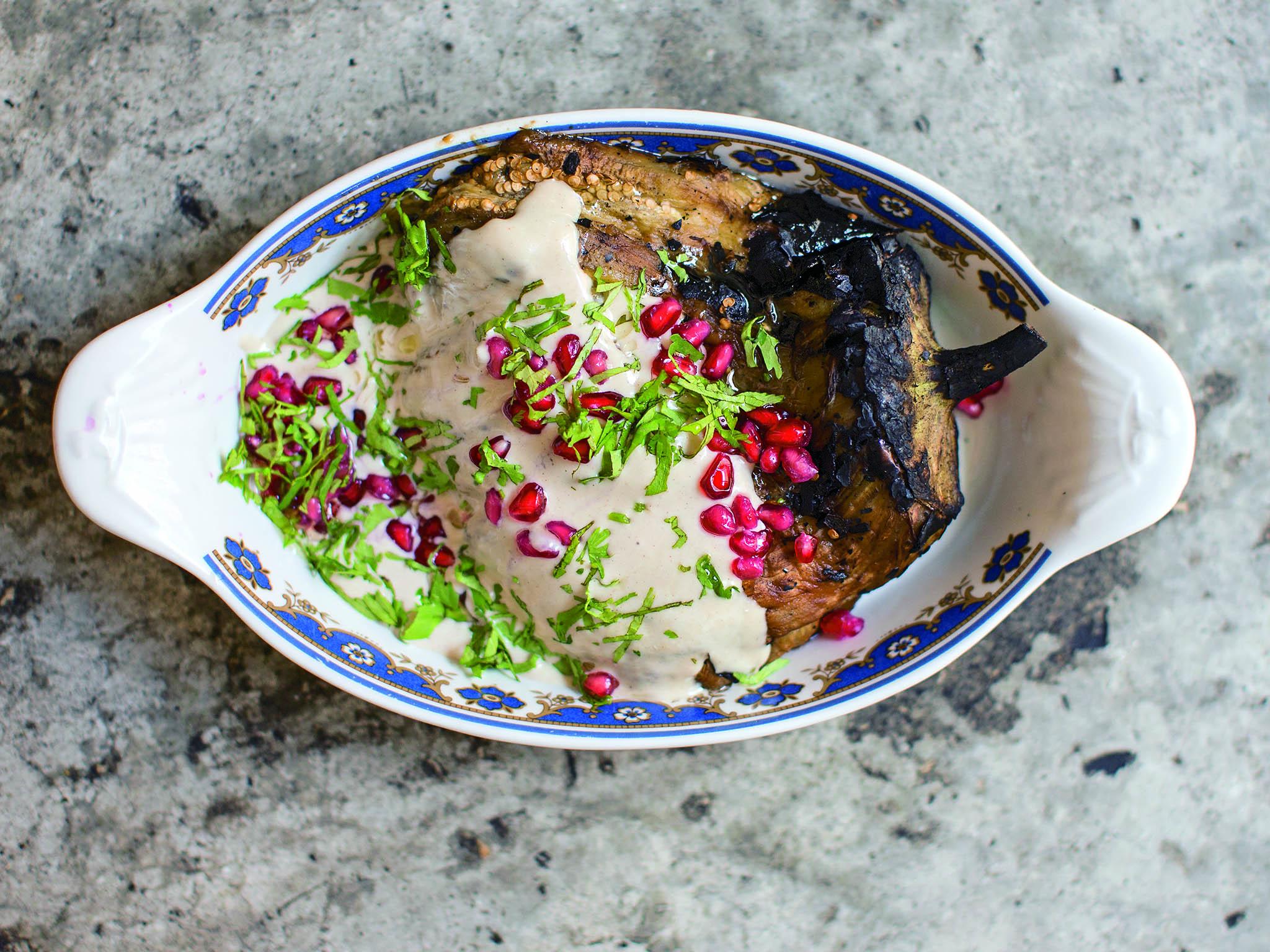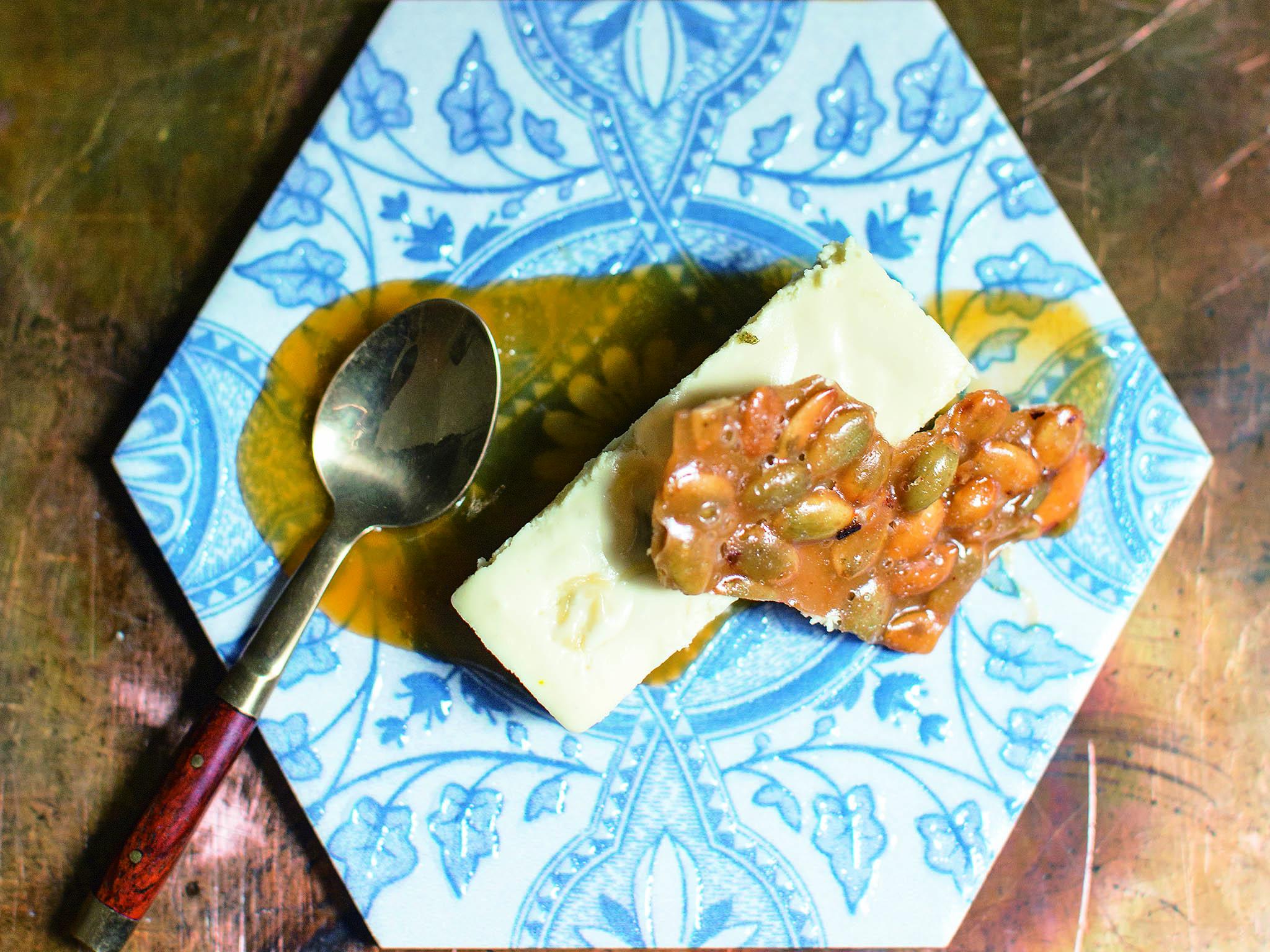Palomar cookbook recipes: from burnt aubergine with pomegranate to Stilton cheesecake
From the award-winning Palomar restaurant comes its first cookbook with more than 100 recipes of fusion food from Southern Spain to the Levant

Your support helps us to tell the story
From reproductive rights to climate change to Big Tech, The Independent is on the ground when the story is developing. Whether it's investigating the financials of Elon Musk's pro-Trump PAC or producing our latest documentary, 'The A Word', which shines a light on the American women fighting for reproductive rights, we know how important it is to parse out the facts from the messaging.
At such a critical moment in US history, we need reporters on the ground. Your donation allows us to keep sending journalists to speak to both sides of the story.
The Independent is trusted by Americans across the entire political spectrum. And unlike many other quality news outlets, we choose not to lock Americans out of our reporting and analysis with paywalls. We believe quality journalism should be available to everyone, paid for by those who can afford it.
Your support makes all the difference.Cod chraymeh
Serves 4
The name of this North African fish stew is derived from the word chraimee, which in slang means “bastard”, and alludes to the way of preparing and eating this dish – fast and hot, almost “stealing” it by snatching it up quickly with a piece of bread. Basically, it’s a great and fast way to cook a nice piece of fat fish for fortifying the labourers of Libya, Algeria, Tunisia and Morocco on their lunch breaks. Chraymeh found its way into the Jewish kitchen as a quick fish dish for just before the Sabbath enters, since it is the custom on a Friday always to have a fish course before the meat. It has now been taken into the heart of almost every Israeli household as the official Friday night fish dish, and even Ashkenazi – originally Eastern European – households cook it with joy.
In this recipe I use fresh red peppers and canned tomatoes because I like mine chunky – alternatively you can use tomato purée and some water if you prefer a smooth texture. Although I use cod here, any white flaky fish will do, such as hake or halibut, and feel free to turn it into a seafood festival by adding clams, mussels, prawns and even scallops, all poached quickly in the fragrant red stew.
4 tbsp rapeseed oil
1-3 red chillies, sliced (depending on how hot you like it)
5 red peppers, cored, deseeded and cut into 1.5cm fingers
5 garlic cloves, sliced
1 tbsp sweet paprika
1 tsp toasted and ground cumin seeds
5 tbsp aniseed-flavoured spirit, such as arak, Pernod or ouzo (optional)
100ml water
1 tbsp harissa
400g can good quality chopped tomatoes
pinch of sugar
4 cod fillets, 150g each, skinned
salt, to taste
1 large bunch of coriander, chopped
squeeze of lemon juice
Heat a large saucepan or a wide, shallow pan over a medium heat, add the oil, chillies and peppers and sauté for 15 minutes, stirring occasionally. Add the garlic and half the dry spices and cook for a further 5 minutes. Add the aniseed-flavoured spirit (if using) and crank the heat up to allow the alcohol to vaporise, then add the water and harissa and stir for a while. Next add the tomatoes and sugar, then leave the stew to simmer for 10-15 minutes before adding the rest of the spices.
Season the cod fillets with salt, then gently slide them into the stew. If you’re using shellfish (mussels, clams, scallops, etc), now is a good time to add them. Add half the coriander and simmer for another 5 minutes.
Add a squeeze of lemon juice, give the stew a good shake and check for salt, then turn off the heat and leave it to rest for 5 minutes before you serve, topped with the rest of the coriander. In my house, we put the pan straight on the table and everyone helps themselves. Grab a fork in one hand and a piece of bread in the other.

Burnt aubergine with tahini and pomegranate
2 aubergines, charred over an open flame and peeled (see below)
salt and pepper, to taste
juice of ½ lemon
4 tbsp extra virgin olive oil, plus an extra drizzle to garnish
For the garnish
4 tbsp white tahini sauce (see below)
4 tbsp pomegranate seeds
handful of chopped fresh coriander
You can think of this as a deconstructed baba ganoush. To get the maximum flavour from the aubergines, it’s best to char them over an open flame on the hob or on a charcoal barbecue.
Arrange the whole burnt, peeled aubergines on a serving plate, then season to taste with salt and pepper and dress with the lemon juice and olive oil. Drizzle the white tahini sauce on top, sprinkle with the pomegranate seeds and the chopped coriander and drizzle with a little more olive oil. You can keep the peeled aubergines in an airtight container in the fridge for 2-3 days and then, when you want to serve, simply heat them up and add your garnishes.
Charred aubergine
Prick the aubergines in several places with the tip of a sharp knife so that they won’t explode in your face and make a mess in the kitchen. Char the skin of the aubergines on all sides over an open flame on the hob or hot charcoal on a barbecue, turning every 5-6 minutes – the skin needs to harden up and get a bit crispy. There is a third option: set your grill to the highest setting and roast the aubergines in the closest position to the heat source, turning in the same way. Leave the aubergines until cool enough to handle, then peel.
White tahini sauce
Makes 500ml
250ml tahini paste
200-250ml ice-cold water
50ml freshly squeezed lemon juice
salt, to taste
For a good tahini sauce, you need to start with a good tahini paste. Personally, I like Lebanese tahini, as it’s rich and natural – the brand I use in the restaurant is Al Nakhil. Some like their tahini sauce with garlic, which I find overpowering; I like to really taste the sesame when I eat it. Tahini is really the Master Paste, as you can put it on almost anything and it will make it better. But my favourite tahini marriage is with bread or pitta. Any time of day or night is a good time to mop up some tahini with pitta; so simple but so tasty.
Before you start, it’s important to point out that every tahini paste is a bit different, so the volume of water needed will change from brand to brand. The good news is that, if you add the water slowly, you’ll easily be able to judge when you’ve hit the right texture. And what is the right texture, you ask? It all depends how you like it! I like it to be somewhere in the middle so that when you dip a spoon and lift it, the tahini oozes down slowly. There’s no right or wrong – some like it very runny (like my wife), some like it thick and dense (like my mama and papa) and me, I like it in the middle!
Spoon the tahini paste into a bowl, add the water gradually and beat constantly with a whisk. At first the tahini will become denser (don’t panic!) and then it will start to loosen up. Stop when you hit the texture you like. Add the lemon juice and salt to taste. You can keep the sauce refrigerated, tightly covered with cling film, for up to 2 days (it goes a bit thicker in the fridge).

Stilton cheesecake
Serves 12
One day Zoe came to me with a special request – a cheese course, but not the predictable cheese and biscuits. Not that there’s anything wrong with that, but this had to be special. As a sworn cheese fan myself, I was happy to take on the challenge. I have to admit that this cheesecake isn’t for everyone – it’s definitely for the more adventurous dessert eaters out there. The dish is a bit of a rollercoaster of flavours and textures, combining savoury, sweet, spicy, crunchy and smooth all at the same time. The cake itself is very easy to make. If you’re in a hurry you can simply serve it with a variety of fruits. But if you want to go the whole hog (and trust me, you do), I’ve included recipes for an accompanying coulis and tuile, just as we serve it in the restaurant. The tuile makes the perfect snack on its own, so I would definitely recommend making a few more of these while you’re at it – after all, it’s hard not to pinch a tuile or three along the way.
For the cake
375g full-fat soft cheese
100g honey
1 egg
15g blue Stilton cheese, crumbled
1 tsp salt
For the apricot coulis
150g apricots (3-4), pitted
50g granulated sugar
1 tbsp water
For the pumpkin seed tuile
40g granulated sugar
15g glucose
30g butter
2 tsp milk
40g pumpkin seeds
1 tsp cornflour
2-3 pinches of chilli flakes
To make the cheesecake, preheat your oven to 180°C/160°C fan/350°F/Gas 4 and line a 650g loaf tin with baking parchment. Mix all the ingredients together in a mixing bowl, then pour the mixture into the lined tin. Bake for 25-30 minutes until it is firm but with a slight wobble when you shake it gently - a bit like a jelly. Place in the fridge until completely cool, then it’s ready to cut and serve. It will keep in the fridge for up to 3 days.
To make the apricot coulis, place all the ingredients in a saucepan and cook over a medium heat for about 20 minutes until the apricots have softened.

Transfer to a blender and blend until smooth, then pass through a fine sieve for an ultra-smooth texture. The coulis will keep in an airtight container in the fridge for up to 4 days.
To make the pumpkin seed tuile, preheat your oven to 190°C/170°C fan/375°F/Gas 5. Place the sugar, glucose, butter and milk in a heavy-based saucepan and heat to 110°C (230°F). Remove the pan from the heat, add the pumpkin seeds and cornflour and mix to combine.
Using a rolling pin, roll the mixture out into a thin layer between 2 sheets of baking parchment. Do this while the mixture is still hot, otherwise it will start to set and will be hard to roll thinly. Remove the top sheet of baking parchment, then transfer the flattened tuile mixture, still on the bottom sheet of baking parchment, to a baking tray. Scatter the tuile with the chilli flakes and bake for 12 minutes until it is an amber caramel colour.
Remove from the oven and leave to cool completely. Break the tuile up into pieces and transfer to an airtight container, where it will keep for up to 2 weeks. To serve, cut the cake into 12 equal-sized pieces. Place a teaspoon of the apricot coulis on each serving plate and top with a piece of the cake and a piece of tuile.
The Palomar Cookbook, published by Mitchell Beazley, £25
Join our commenting forum
Join thought-provoking conversations, follow other Independent readers and see their replies
Comments